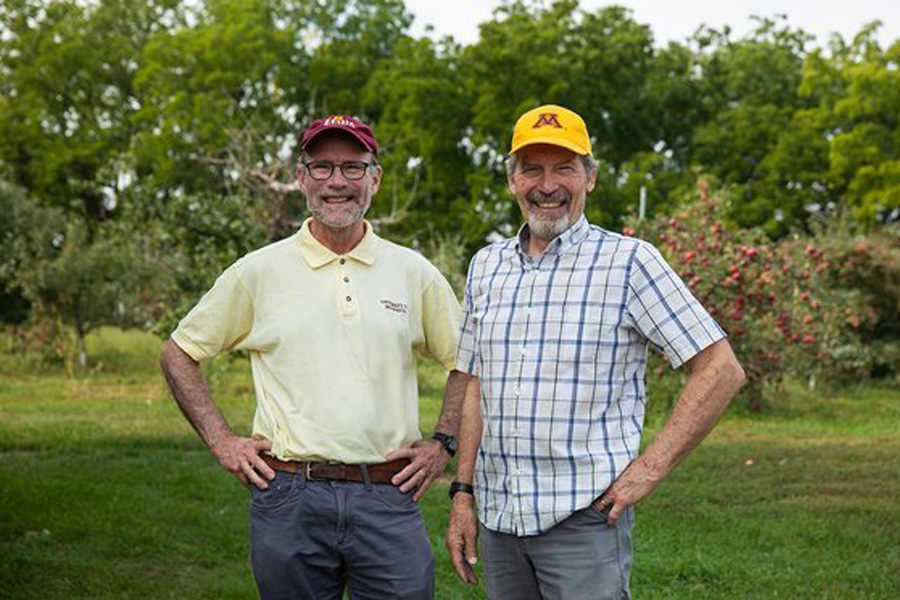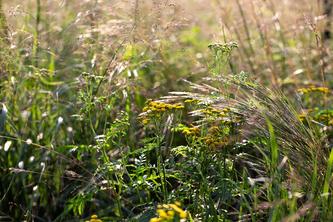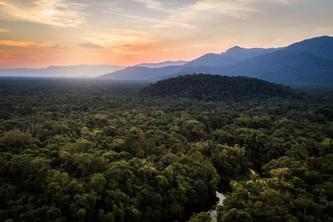
If you enjoy a Honeycrisp, Haralson, SweeTango®, or First Kiss® apple at your local orchard or farm stand this fall, you can thank the University of Minnesota apple breeding program for putting it there.
Through the development of cold hardy and great tasting apples, the U of M apple breeding program has been sustaining Minnesota’s small but thriving commercial apple industry since the early 1900s.
Professor James Luby and Senior Research Fellow David Bedford, both in the College of Food, Agricultural and Natural Resource Sciences (CFANS), have led the U of M apple breeding program for the past four decades. During their tenure, the program has gained international acclaim and raised the bar for what consumers consider a good apple.
Developing diamonds in the orchard
The apple breeding program released its first superstar, the Haralson, 100 years ago — and many of the basics of apple breeding haven’t changed since Haralson was developed.
Researchers identify “parent” apples with characteristics they’d like to combine. For example, one parent may be disease resistant but not crisp and the other parent may be crisp but not disease resistant. The parents are crossed with the goal of developing a new cultivar that is both disease resistant and crisp. It’s a multiyear process that involves cross-pollination and planting new seedlings.
The real evaluation begins when the trees bear fruit. Researchers taste the fruit of each tree—up to 600 apples per day—and decide if each one is worth keeping around or not. Very few of the thousands of apples that get tasted each growing season make it past the first round of tasting; typically only 10 to 12 each year.
“It's really a matter of looking for the diamonds in the rough and throwing away the rest,” says Bedford. “That ‘throwing away the rest’ is really what we do most days, but finding that diamond is still fun when you only find 10 a year.”
From initial cross breeding to public release, it takes 20 to 25 years to develop and release an apple variety.
Raising the bar: From Haralson to Honeycrisp
Haralson was considered a great tasting apple in its time and is still grown in Minnesota, but it likely wouldn’t make it past Luby and Bedford’s first round of tasting today.
Even with the advances that have been made, only about one in every 10,000 trees produced in the initial breeding is good enough to make it through the entire breeding and evaluation process to be named and commercialized.
“Some of the seedlings that we throw away without a second thought today could have been potential winners 25 years ago, but the bar is just much higher now,” Bedford says.. “And the release of the Honeycrisp in the ’90s was instrumental in raising that bar.”
Honeycrisp very quickly became the most widely grown variety in Minnesota and one of the top varieties in the United States.
“I think what we're going to see as part of the great legacy of Honeycrisp is that a lot of the new varieties that are now coming out and coming to your supermarket are actually the children of Honeycrisp,” Luby says. “It's been used a lot in breeding programs, not only here in the United States, but in Europe and China as well.”
Several apples developed from Honeycrisp’s genetics are already on the market from other apple breeding programs. The U of M’s most recent apple releases, First Kiss® (known as Rave® when grown outside of Minnesota) and Triumph®, are also children of Honeycrisp.
It’s too early to tell if First Kiss®, Triumph®, or one of the University’s yet-to-be-released apples will surpass Honeycrisp as the top apple variety in Minnesota or rise to Honeycrisp’s level of success. But one thing is certain—the U of M will continue its pioneering science to fill apple carts, and tantalize taste buds, around the world.
- Categories:
- Agriculture and Environment
- Food





